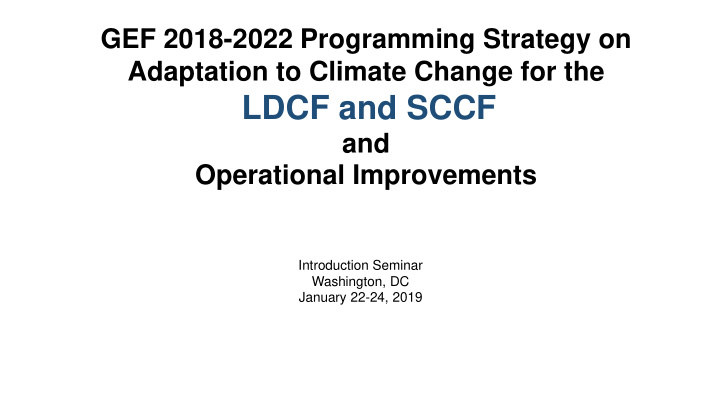



GEF 2018-2022 Programming Strategy on Adaptation to Climate Change for the LDCF and SCCF and Operational Improvements Introduction Seminar Washington, DC January 22-24, 2019
Strategy Highlights Goal: to strengthen resilience and reduce vulnerability to the adverse impacts of climate change in developing countries, and support their efforts to enhance adaptive capacity continue to serve UNFCCC and complementarity enabling countries to better utilize a range of climate funds to develop harmonized adaptation solutions mainstreaming adaptation Facilitating private sector, enhancing resilience Innovative Strategic Gender responsive Developing capacity
Building on Comparative Advantage… Country-driven and global National: NAPA, NAPs, translating NDCs into action Global: addressing gaps, vetting concepts, capacity building, LDC work programme Ability to offer integrated solutions Multiple benefits, MEA-relevant, alignment of relevant SDGs Focus on innovation SCCF evaluated as “ideal incubator” to test and refine concepts Demonstrated track record for delivery Supporting over 330 adaptation projects Assessed as highly effective, impactful, and with value for money in independent evaluations, donor reviews
LDCF 2018-2022
LDCF Objectives and Entry Points Innovation in priority sectors, Objective 1 themes & private sector Reduce vulnerability and increase resilience through Climate security innovation and technology transfer for climate change adaptation Incubation and accelerator support Objective 2 Mainstream adaptation across Mainstream climate change GEF focal areas and IPs adaptation and resilience for systemic impact Innovative partnerships Support to NAP process Objective 3 Support for LDC work Foster enabling conditions for programme effective and integrated climate change adaptation Support for enabling activities
SCCF 2018- 2018-2022 2022
SCCF Overview Benefits Support for highly vulnerable, non-LDCs, e.g., low-lying SIDS Support cost-effective, regional and global programming Effective : highly likely to deliver tangible adaptation benefits and catalytic effects Unique Value: accessibility for non-Annex I countries support for innovative adaptation projects (IEO, 2017) Challenges: Unpredictable funding: identified in evaluations as a key constraint Limited resources: $6 million average annual pledges and funding approvals
SCCF Objectives and Entry Points Objective 1 Reduce vulnerability and Challenge Program for increase resilience through adaptation innovation innovation and technology transfer for climate change adaptation Objective 2 Incentive for mainstreaming Mainstream climate change adaptation and resilience adaptation and resilience for systemic impact Objective 3 Support for enabling activities in Foster enabling conditions for response to COP guidance effective and integrated climate change adaptation
Enhanced Private Sector Engagement Pillar 1 : Expanding catalytic grant (LDCF) and non-grant investments (SCCF) Pillar 2 : Support enabling environments for the private sector to act as an agent for market transformation.
Recommend
More recommend